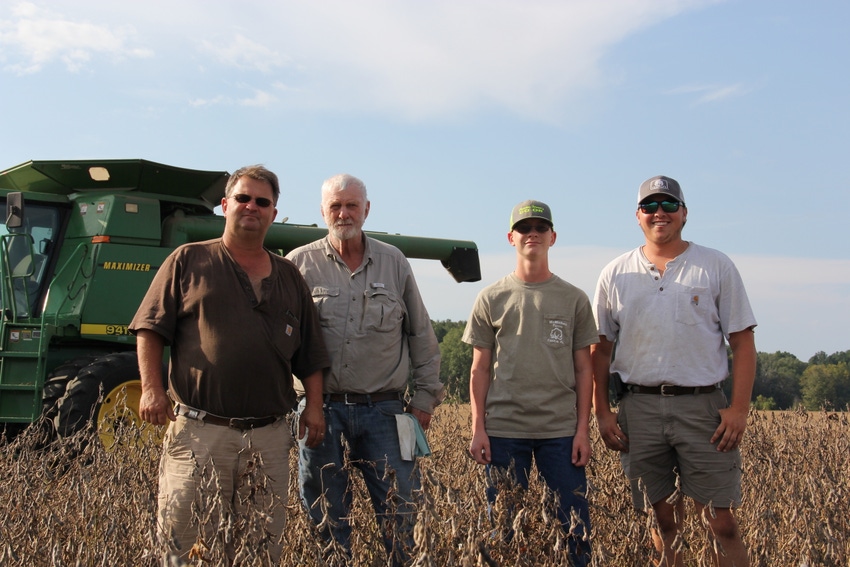October 28, 2017

McMichen Farm became the first Alabama farm to hurdle the 100-bushel soybean barrier with 102.158 bushels per acre.
The farm, near Centre, Ala., has been in the family since 1842 and consists of Nick McMichen and his wife, Freida, along with his father, Randall, and son Matt. Tyler Bruce, who is engaged to Nick’s daughter Mindy, joined the operation in 2015.
The record yield was entered in Matt’s name, but Nick says it was a family effort and a blessing from the Lord. Nick quotes his favorite Bible verse Psalm 67:7, “Then the land will yield its harvest, and God, our God will bless us. … The Lord made the 100 bushels, we are merely his stewards.”
The McMichens will be recognized at the Alabama Farmers Federation Commodity Organizational meeting in February as the first winners of $10,000 Soybean 100 Bushel Yield Contest. The contest is funded by the Alabama Soybean Producers.
Alabama Farmers Federation’s Carla Hornady, who is director of the organization’s soybean division, said Alabama farmers saw growers in other states making 100-bushel yields and wanted to encourage farmers in their own state to reach the goal.
“In 2015, our state Soybean Producers Committee decided to fund Extension specialists Mark Hall and Dennis Delaney’s proposal for the $10,000, 100-bushel yield challenge so our growers would try different production practices to see if they could make higher yields,” Hornady said. “We congratulate the McMichens as our first winner.”
Mark Hall was thrilled to have a 100-bushel winner after over 50 entrants in the challenge over the last three years. “While only one farm made the 100-bushel challenge, many entrants made record farm yields,” he said.
McMichen also credits the Alabama Cooperative Extension System for helping develop a plan he used to break the 100-bushel mark. “We came close to the 100-bushel mark in the past, but I really worked close with the Alabama regional Extension agent and specialists to develop a production scheme to get me over the hump,” he said. “They advised to plant earlier to have pod fill during the longest days of the year to take advantage of extra sunlight.”
The McMichens planted Pioneer 47T36 no-till in 30-inch rows at 140,000 seeds per acre on April 14. Ideal weather provided excellent emergence and a final stand count of 125,000 plants per acre.
“We were blessed with rain this year, and the beans didn’t suffer for moisture,” McMichen said. “I only irrigated four times, with .4 inches during each irrigation.”
“This goes to show our farmers are just as capable of making as high yields as growers anywhere,” said Auburn University Extension specialist Dr. Dennis Delaney. “Alabama farmers have invested in research to increase yields and profitability through the Alabama Soybean Producers Committee and soybean check-off fund. Nick has supported our efforts by having cotton and soybean variety trials. I am glad to see his efforts pay dividends. The information we collect from on-farm trials like his are a great asset in helping Alabama growers make better decisions to increase crop profitability.”
Fertility and Tissue Sampling Key
The McMichens applied two and a half tons of chicken litter to the field before planting. ABM Graph-Ex SA inoculant and seed lubricant were applied to the seed to maximize the plant’s nitrogen production. Weekly tissue samples were taken from the farm’s 2016 soybean crop that made 86 bushels per acre and discovered a shortage of potash — a common deficiency in high-yielding soybeans. Potash (K) levels decline rapidly in the leaf during pod fill as potash is translocated from the leaf to the beans. K levels above 1.75 percent in the leaf are preferred as long as possible. Last year, the K level in the leaf tissue samples dropped to 1.18 percent at pod fill and prevented the beans from getting the size needed to make a 100-plus bushels.
Bean Size Critical in High Yields
The McMichens’ soybeans averaged 2,140 beans per pound, which meant much of the yield came from the bean’s huge size. Normally, soybeans average between 2,800 and 3,100 beans per pound. McMichen said he learned a great deal from taking tissue samples the last two years. For high yields, adequate potash levels are required during pod fill. He applied 100 pounds of 0-0-60 and 40 pounds of ammonium sulfate per acre over-the-top of the beans at R3, when the pods began to fill. This application was key in getting bigger beans and increasing yields.
Controlling Pests a Must
The McMichens two biggest weed problems are pigweed and morningglories. Roundup and Sharpen were applied at burndown, they then followed up with Roundup and Dual at early postemergence. Two weeks later, an application was made with Roundup and FirstRate, resulting in excellent weed control.
McMichen made a protective ground-applied fungicide application with Quadris at R3. He added Dimilin to give season-long suppression of soybean loopers, beanleaf beetles and other leaf-feeding pests; a pyrethroid for stinkbug and kudzu bug control; and boron with this application. Fields were scouted three weeks later and some minor frogeye leafspot and downy mildew development were noted. To ensure excellent yield potential, a follow-up aerial application of Priaxor was made.
Another key component to the McMichens’ high yield was timely harvest. Gramoxone was applied before harvest and the soybeans were harvested September 8.
“The early-season soybeans were more profitable than corn,” Nick said. “My corn acreage will be limited next year. Early-season beans will take preference over corn, but commodity prices will eventually dictate what I plant.”
Eddie McGriff is an Alabama Regional Extension Agent in Northeast Alabama.
About the Author(s)
You May Also Like




